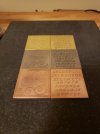alwayslearning2012
Member
While I am still in the beginning stage of this art form, I have not been blind to the fact that in many of the you-tube videos I watch, the gravers, for the most part, are polished. When I took my basic hand class, we took it to 1200 on the Graverhone and that was the end of it.
I'm guessing that the class was designed to give the pupil the basics of what he/she needs to know to travel along on their path.
Since my recent lesson in stainless has taught me a thing or two, I've decided to devote some time to sharpening a modest supply of gravers in preparation for my next practice session. This time , of course, will be in much softer metal. But, before I get them all to 1200, a question emerged in my head. "Why would I need to go further?"
So the question has been posed.
Why does anyone polish a graver to a mirror finish? and why?
I'm guessing that the class was designed to give the pupil the basics of what he/she needs to know to travel along on their path.
Since my recent lesson in stainless has taught me a thing or two, I've decided to devote some time to sharpening a modest supply of gravers in preparation for my next practice session. This time , of course, will be in much softer metal. But, before I get them all to 1200, a question emerged in my head. "Why would I need to go further?"
So the question has been posed.
Why does anyone polish a graver to a mirror finish? and why?








